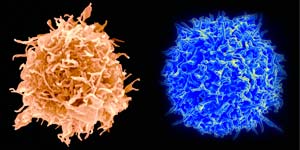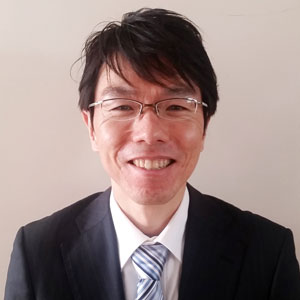Apr. 21, 2017 Research Highlight Biology
To B or not to B
Epigenetic mechanisms help determine whether immune precursors become T-cells or B-cells
 Figure 1: Epigenetics determines whether an immune precursor becomes a B-cell (left) or a T-cell (right). © Science Photo Library - STEVE GSCHMEISSNER/Getty (left image) and © National Institutes of Health/Stocktrek Images/Getty (right image)
Figure 1: Epigenetics determines whether an immune precursor becomes a B-cell (left) or a T-cell (right). © Science Photo Library - STEVE GSCHMEISSNER/Getty (left image) and © National Institutes of Health/Stocktrek Images/Getty (right image)
To defend against invading pathogens, the body’s immune system creates two main types of white blood cells: T-cells, which recognize infected tissues, and B-cells, which help mount an antibody attack. Whether a blood stem cell turns into a T-cell or a B-cell depends partly on the activity of regulatory proteins known as transcription factors. Now, a study led by RIKEN researchers indicates that epigenetic mechanisms—changes that affect gene activity and expression but leave the sequence of genes in DNA unaltered—play a critical role as well1.
During development, cell progenitors have the potential to become various kinds of cells. Which kind they become was thought to depend primarily on transcription factors, with epigenetic processes later confirming that choice.
Now, a team led by Tomokatsu Ikawa of the RIKEN Center for Integrative Medical Sciences has uncovered an exception. They engineered mice that lack the machinery needed to epigenetically activate or silence genes in their T-cells. This machinery works by modifying DNA-packaging proteins called histones. It involves what are known as polycomb proteins. Specifically, the T-cells of the mice lacked two particular polycomb proteins, Ring1A and Ring1B.
 Figure 2: Tomokatsu Ikawa and co-workers have discovered that epigenetic mechanisms help determine whether immune precursors become T-cells or B-cells.
Figure 2: Tomokatsu Ikawa and co-workers have discovered that epigenetic mechanisms help determine whether immune precursors become T-cells or B-cells.
These mice, the researchers found, had T-cells that halted their development prematurely. However, these arrested T-cell precursors could be transferred to other mice where they would form functional B-cells. “This was unexpected since there had been no reports that showed the conversion of T-cells into B-cells in any knockout mouse models,” says Ikawa, adding: “This is the first study showing that the inactivation of epigenetic machinery results in a cell fate conversion.”
Ikawa’s team dug deeper into what the Ring1A/B proteins normally do in T-cells and found that the proteins bind directly with genes involved in B-cell development. That hinted that some determinant of B-cell fate might still be active in the T-cell precursors in the absence of the epigenetic machinery. But what could that determinant be?
The researchers’ prime suspect was a transcription factor called Pax5, which Ikawa describes as “a master regulator of B-cell differentiation.” He and his colleagues eliminated Pax5 activity along with the epigenetic equipment in the mice. This fully restored normal T-cell differentiation. “This indicates that Pax5 is one of the most important targets of Ring1A/B at this developmental stage,” Ikawa explains.
Because Ring1A/B and related proteins are often deregulated in various types of cancer, including leukemia, the research could lead to new insights into the tumor-initiating process.
Related contents
- Blocking differentiation is enough to give cells “stemness”
- Japanese team creates cancer-specific killer T cells from induced pluripotent stem cells
- Tracing lymphocyte development signaling pathways
References
- 1. Ikawa, T., Masuda, K., Endo, T. A., Endo, M., Isono, K., Koseki, Y., Nakagawa, R., Kometani, K., Takano, J., Agata, Y. et al. Conversion of T cells to B cells by inactivation of polycomb-mediated epigenetic suppression of the B-lineage program” Genes & Development 30, 2475–2485 (2016). doi: 10.1101/gad.290593.116
